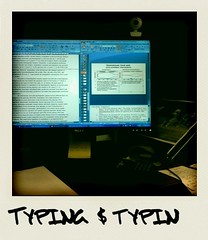 |
| Sediment erosion and tree loss |
Friday, December 17, 2010
Sediment erosion and land, no no tree loss
As a foreign student from a small but heavily-developed and very-over-populated country, sediment erosion seemed to be the story which can be hardly seen because most of coast is also hardened with concrete to build buildings, roads, etc.. But here in the Chesapeake Bay and its tributaries, it is occurring literally every where.
This is really faster than I expected. I had practiced martial art with Jeff and Dave two years ago when these trees made shadow for us.
Saturday, December 4, 2010
How to save sea birds?
When I worked at Scripps Institution, Nacho (PhD student) showed me the effects of sea birds on marine ecosystem. I can't remember exactly but his study was very unique. The birds we see everyday is an important part of foodweb because it feeds on fish, crab, and clam. Also, birds may supply nutrients on the surface again by excretion which phytoplankton and bacteria can take up.
Today, for the first time, I seriously think that we all need to appreciate the friends and provide more protection after i met this bird. The bird was still alive with a heavy fishing weight in its mouth. There was nothing i can do much because i couldn't find a hook. The bird swallows the hook. Emm, i don't think I can go fishing anymore.
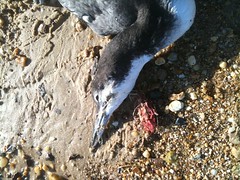
Rest in peace.
Today, for the first time, I seriously think that we all need to appreciate the friends and provide more protection after i met this bird. The bird was still alive with a heavy fishing weight in its mouth. There was nothing i can do much because i couldn't find a hook. The bird swallows the hook. Emm, i don't think I can go fishing anymore.

Rest in peace.
Monday, September 27, 2010
Arduino project 2
Finally, today I got almost all arduino parts to make the automated valve. I have found many useful blogs and forum from which I can get help but I still have some hard time to figure out what all small parts are intended for.
But for now, I would like to introduce the design I am thinking.
Ok, can I do this? Emm, it is going to be not easy but it worth to try.
But for now, I would like to introduce the design I am thinking.
 |
| DIC analyzer and automated samples which I am going to make. |
Saturday, September 25, 2010
Arduino project
I know there are many genius out there. But when I look at people working on electricity, I think they are really smart! How come they know all circuits and make it work.
Now, I also want to learn about electricity and make some useful tools. So, I have tried to find people out there who willingly teach me and share their knowledge with free of charge. It seems like people in a remote control world are the best I found. However, I have to spend much money to participate in their meeting (i.e., buying stuff). But I can't afford that much money.
My adviser, Jeff, asked me to make some automated sampler for one equipment which we just purchase on August. This equipment is to measure dissolved carbon in water. Unfortunately, it takes long time to finish one sample. That's why he asked me to think or invent an automated tool. Now, I feel like I find my new hobby: Arduino. It is kind of small scale computer but more flexible and unlimited! And CHEAP!
So, this is Arduino main board. I am going to make a rotating valve on which many samples will be connected. The valve needs to communicate with computer and Arduino to ensure the timing of switching between samples with the measurement.
I can be hard,,very hard to me because I have no experience in computer language and electricity. But I am ready to do it.
Now, I also want to learn about electricity and make some useful tools. So, I have tried to find people out there who willingly teach me and share their knowledge with free of charge. It seems like people in a remote control world are the best I found. However, I have to spend much money to participate in their meeting (i.e., buying stuff). But I can't afford that much money.
My adviser, Jeff, asked me to make some automated sampler for one equipment which we just purchase on August. This equipment is to measure dissolved carbon in water. Unfortunately, it takes long time to finish one sample. That's why he asked me to think or invent an automated tool. Now, I feel like I find my new hobby: Arduino. It is kind of small scale computer but more flexible and unlimited! And CHEAP!
 |
| My first Arduino main board! |
I can be hard,,very hard to me because I have no experience in computer language and electricity. But I am ready to do it.
Friday, September 10, 2010
Life in the Dead Zone project
o far I have worked in Life in the Dead Zone project for about 3 months. I went to total 3 cruises including a one-week long cruise (LDZ4) and two one-day boat (LDZ5 & 6). Most of data are analyzed with DIC analyzer and membrane inlet mass spectrometer. Unfortunately, I had badly cut my finger and lost some skin due to broken glass vial but I am glad my wound is not so bad.
Classes are also begun from the last week: Environmental Geo Chem I and Oil spill seminar this 2010 fall semester. It is going to be fun, difficult, but most importantly very useful for my study.
Today, I have finally made two important plot: Scanfish plot of LDZ4 and DIC flux from sediment of LDZ 4.
In the figure above, most importantly, dead zone (no oxygen) was clearly observed below about 10 m in the mesohaline (middle) of Chesapeake Bay. Then, was there any living organisms which can produce energy by performing respiration without oxygen?
Not many studies have measured DIC in the dead zone. The figure above clearly shows that there are heterotrophic and/or chemoautotrophic bacteria using other electron acceptors other than oxygen alone. Now, I am very excited to show people that there are lives in the dead zone!
Classes are also begun from the last week: Environmental Geo Chem I and Oil spill seminar this 2010 fall semester. It is going to be fun, difficult, but most importantly very useful for my study.
Today, I have finally made two important plot: Scanfish plot of LDZ4 and DIC flux from sediment of LDZ 4.
 |
| LDZ4 Scanfish (oxygen, salinity, temperature, fluorescence) |
In the figure above, most importantly, dead zone (no oxygen) was clearly observed below about 10 m in the mesohaline (middle) of Chesapeake Bay. Then, was there any living organisms which can produce energy by performing respiration without oxygen?
 |
| Dissolved inorganic carbon measurement |
Friday, August 27, 2010
Computer programs?....nooo...not today. But motivation
Yes, scientists use lots of different computer software, namely, Microsoft office, Adobe Creative Suite, Mathematica, Matlab, etc. And there are lots of 'small & simple' programs specialized for certain forms of data. I purchased a student version of Matlab a few days ago and pretty suffered from it because it crash with Windows 7 computer.
But this is not what I want to talk about today. I want to talk about motivation.
As a oceanography graduate student, I am very tempting to make nice figures, animations, graphics showing scientific data into world. But it takes too long time since I don't have any computer background. In fact, I took a Matlab related course once and that's pretty much it. Sometimes, I spend more time for playing with computer software than reading a book or paper, then I feel guilty about it. So to speak, I have a strong motivation for extracurricular activity than just my job.
As a person from S.Korea, I am (actually was) very scared of professors or teachers. They are supervisor and master of my life and traditionally I must respect them, but cannot love them much. However, my thoughts of teacher was changed after I met Dr. Raleigh Hood at Horn Point Lab. He is not only a master but a friend. He allowed me anything I wanted to do in his laboratory and didn't blame me even if I was deserved. More importantly, though, he changed the perspective of motivation of mine. He let me do whatever I want to. I worked because I should and I believed that it is one kind of motivation in a different shape. Especially, the personality was securely developed during my military service period. But here, we don't call it motivation, but just a order.
Today, my blog is much longer than before because I am very happy after watching a video. Dan Pink in the video talks about motivation and productivity. In scientific studies, it turns out that productivity is lower when people are rewarded by his/her work than people are not rewarded at all especially if the work requires any little creativity. I clearly remember many of my friends who said that their parents will buy this toy, that toy, this game, that game if they got a good score from the test. And the reward seemed to work because they get better scores than mine who never got this kind of offer from parents. But now, I see that my parents are much more wiser than other parents. I cannot say that I am a more productive person than they are now because I don't know what they are doing and I don't think I am very successful right now. However, I believe that I have more potential than them because I have been doing whatever I want without any incentive. I am going to enjoy my life more seriously from today for the higher productivity.
Conclusion of today's blog. Although I spend many time for playing with softwares which I don't need to do, it will make my life much more productive than ever.
But this is not what I want to talk about today. I want to talk about motivation.
As a oceanography graduate student, I am very tempting to make nice figures, animations, graphics showing scientific data into world. But it takes too long time since I don't have any computer background. In fact, I took a Matlab related course once and that's pretty much it. Sometimes, I spend more time for playing with computer software than reading a book or paper, then I feel guilty about it. So to speak, I have a strong motivation for extracurricular activity than just my job.
As a person from S.Korea, I am (actually was) very scared of professors or teachers. They are supervisor and master of my life and traditionally I must respect them, but cannot love them much. However, my thoughts of teacher was changed after I met Dr. Raleigh Hood at Horn Point Lab. He is not only a master but a friend. He allowed me anything I wanted to do in his laboratory and didn't blame me even if I was deserved. More importantly, though, he changed the perspective of motivation of mine. He let me do whatever I want to. I worked because I should and I believed that it is one kind of motivation in a different shape. Especially, the personality was securely developed during my military service period. But here, we don't call it motivation, but just a order.
Today, my blog is much longer than before because I am very happy after watching a video. Dan Pink in the video talks about motivation and productivity. In scientific studies, it turns out that productivity is lower when people are rewarded by his/her work than people are not rewarded at all especially if the work requires any little creativity. I clearly remember many of my friends who said that their parents will buy this toy, that toy, this game, that game if they got a good score from the test. And the reward seemed to work because they get better scores than mine who never got this kind of offer from parents. But now, I see that my parents are much more wiser than other parents. I cannot say that I am a more productive person than they are now because I don't know what they are doing and I don't think I am very successful right now. However, I believe that I have more potential than them because I have been doing whatever I want without any incentive. I am going to enjoy my life more seriously from today for the higher productivity.
Conclusion of today's blog. Although I spend many time for playing with softwares which I don't need to do, it will make my life much more productive than ever.
Friday, July 23, 2010
Tides in Korea
I went to field trip to Sumjin River in South Korea in summer 2002.
Since Korea is small country, you can see the ocean within 4 hours no matter where you live. Also, ebb-flood tides are so strong that we can observe a huge area of subtidal zone coming out of water twice a day.
I remember here clearly because I had never seen such a beautiful and a broad subtidal sediment.
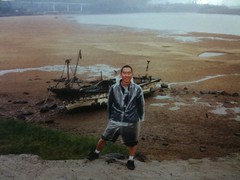 |
| Sumjin River, Korea in 2002 |
Since Korea is small country, you can see the ocean within 4 hours no matter where you live. Also, ebb-flood tides are so strong that we can observe a huge area of subtidal zone coming out of water twice a day.
I remember here clearly because I had never seen such a beautiful and a broad subtidal sediment.
Dirty job in oceanography
People may think oceanographers as scientists using cutting-edge equipment on a comfortable research cruise.
Oceanographic equipment are very expensive because it works under water which is basically stressful environment to machines using electricity due to pressure and 'water' itself. Although this job can be physically challenged due to the characteristics of environment where we work, many research cruises have been built as much as comfortable for scientists. But there are still many oceanographers who want to be dirty, work harder, and avoid any comfort zone at least during the cruise.
Dr. Jeff Cornwell and Mike Owen (faculty research assistant) at Horn Point Laboratory have been collecting estuarine sediments from all over the U.S. more than two decades. Studying bio-geo-chemical mechanisms occurring under the benthic environment is crucial to understand entire ecosystem responses due to high biogeochemical activities of micro and macro organisms under the sediment. As we cannot understand atmospheric reactions (e.g., climate) without knowing the interaction between atmosphere and earth's surface, we cannot find about the function or productivity of 'water' without the understanding of 'sediment'.
This is why we collected sediment core samples from Chesapeake Bay 'no oxygen' zone to find out the biochemical characteristics of the area.
Since the accumulation rate of sediment is on the order of 0.5 to 1 cm per year, these sediment cores which are about 30 cm long is at least 15 to 20 years old (maybe older than you!). It not only has a history of the Bay itself, but also kindly provides all scientific information if we are willing to get.
And don't forget that mud is good for your skin, too!!!
Oceanographic equipment are very expensive because it works under water which is basically stressful environment to machines using electricity due to pressure and 'water' itself. Although this job can be physically challenged due to the characteristics of environment where we work, many research cruises have been built as much as comfortable for scientists. But there are still many oceanographers who want to be dirty, work harder, and avoid any comfort zone at least during the cruise.
Dr. Jeff Cornwell and Mike Owen (faculty research assistant) at Horn Point Laboratory have been collecting estuarine sediments from all over the U.S. more than two decades. Studying bio-geo-chemical mechanisms occurring under the benthic environment is crucial to understand entire ecosystem responses due to high biogeochemical activities of micro and macro organisms under the sediment. As we cannot understand atmospheric reactions (e.g., climate) without knowing the interaction between atmosphere and earth's surface, we cannot find about the function or productivity of 'water' without the understanding of 'sediment'.
This is why we collected sediment core samples from Chesapeake Bay 'no oxygen' zone to find out the biochemical characteristics of the area.
 |
| Sediment Cores |
And don't forget that mud is good for your skin, too!!!
 |
| My 17 yr old dog, Ggang-ggang. |
Labels:
Horn Point Laboratory,
Jeff Cornwell,
Mike Owen,
mud,
R/V Sharp,
sediment core
Monday, July 19, 2010
Zooplankton grazing
If I define oceanography as a student, I would say that this is the study of "everything" from small micro-size to whale-like big organisms and "interactions" between the organisms and environment. I am sure this is not a perfect definition but I just want to say that one oceanographic study must be supported by other studies to become better research. Our project (Life in the Dead Zone) emphasizes not only geochemical cycle of nutrients in the anoxic environment but also biological responses (e.g., bacteria and zooplankton) to see how the organisms react to the stressful environmental condition. This is why we also observed zooplankton activities such as grazing, egg production, etc. This sample below was captured by zooplankton team at Horn Point Laboratory and I found very interesting zooplankton activity which seemed like eating black particulate material which looks alike a fish fecal pellet. Please let me know what Acartia tonsa (zooplankton) was doing here.
Friday, July 16, 2010
R/V Rachel Carson
U of Maryland built a new scientific cruise. It's awesomely pretty and functional. Drs. Boynton, Kemp, Bosch, and many scientists in our school contributed their experience to build this one.
I took this picture during the "Life in the Deadzone" cruise because air condition was broken on the R/V Sharp. We went to Solomons MD to fix it.
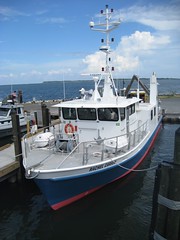
I took this picture during the "Life in the Deadzone" cruise because air condition was broken on the R/V Sharp. We went to Solomons MD to fix it.

Wednesday, July 14, 2010
Sediment and strange man.
Today morning, 4 Delaware University journalists (newspaper publishers?) got on the cruise to see what we are doing. Maybe they are going to report our story on their newspaper.
They took lots of pictures of our works, especially, sediment collection.
This is the picture of Evan Krappe who passionately took pictures on the wet stern. To make it worse we were collecting anoxic bottom sediment which smells like rotten eggs. I'm looking forward seeing his pictures soon.
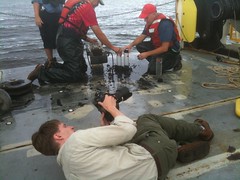
They took lots of pictures of our works, especially, sediment collection.
This is the picture of Evan Krappe who passionately took pictures on the wet stern. To make it worse we were collecting anoxic bottom sediment which smells like rotten eggs. I'm looking forward seeing his pictures soon.

Scanfish MKII
his is one of coolest (I think) oceanographic equipment. It is basically towed by a boat in any aquatic environment where we want to know water properties (i.e., oxygen, temperature, etc.).
Research vessel Sharp towed it on July 9th 2010 in the middle of Chesapeake Bay and this is a part of my new research project: Life in the Dead Zone which is funded by National Science Foundation.

It literally flies up and down in the water column and is controlled by the computer package below:
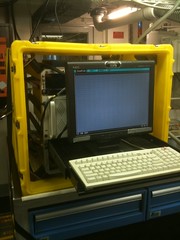
After 'scanning' the water I processed data with Sea-Bird Software which convert data into available numbers. Then, I used Surfer software to draw a following pictures.
X-axis is the latitude and y-axis is the depth of oxygen and salinity
Location:6, Hoopers Island,United States
Research vessel Sharp towed it on July 9th 2010 in the middle of Chesapeake Bay and this is a part of my new research project: Life in the Dead Zone which is funded by National Science Foundation.

It literally flies up and down in the water column and is controlled by the computer package below:

After 'scanning' the water I processed data with Sea-Bird Software which convert data into available numbers. Then, I used Surfer software to draw a following pictures.
X-axis is the latitude and y-axis is the depth of oxygen and salinity
Location:6, Hoopers Island,United States
Friday, May 14, 2010
Typing like a writer
Thursday, January 7, 2010
CTD (conductivity, temperature, depth)
There are so many COOL equipment in oceanography. These are generally expensive because of high precision, toughness, pressure resist, temperature, etc.
One of most essential equipment is CTD (conductivity, temperature, depth). Maybe 1st generation of CTD mainly measure the properties but nowadays scientists use for measuring lots of properties such as oxygen, light, particle concentration, etc. depending on extra sensors you attach on CTD. Also, CTD is equipped with bottles called Niskin that allow collecting water at any depth.

The bottles and all other equipment are controlled on deck.

CTD is best friend!
One of most essential equipment is CTD (conductivity, temperature, depth). Maybe 1st generation of CTD mainly measure the properties but nowadays scientists use for measuring lots of properties such as oxygen, light, particle concentration, etc. depending on extra sensors you attach on CTD. Also, CTD is equipped with bottles called Niskin that allow collecting water at any depth.

The bottles and all other equipment are controlled on deck.

CTD is best friend!
Wednesday, January 6, 2010
Working on research vessels
Yep! Best part in oceanography is working on a research vessel, that is sometimes huge but sometimes not. Tell me good and bad things about that.
1. Big (research vessel (RV) Knorr; 1st picture)
>Good: Lots of food! Amazing and automated facilities including Play Station in a real library. You can see marine animals such as dolphine, seal, or whale often. Pretty safe. Send email to family from personnel computer. Birthday party. Saturday liquor. Hot water.
>Bad: Depression. Sadness. Too long (one month)! American food! No!
-> It was my first experience and I spent one full month in the Pacific. Thanks to the opportunity, I could increase my English But having steaks, macaroni, hamburger,bacon, bread, etc. which were really great but it was a torturing for me (asian). Howeve, it was also great due meeting professors and students from many backgrounds was priceless.

2 Small (Horn Point research vessel)
>Good: Can go back home. Beautiful scenary. There are spectators (birds, people, crabs, etc.). Lunch prepared by me (Asian food). Working cell phone.
>Bad: No liquor. No chefs. No free meals. Tight space and time. Too hot in summer, too cold in winter. If you forget equipment, you already call it a day. Wet.
-> working in Monie Bay, MD. Collecting water and prepare nutrient samples.

Conclusion: There are no easy oceanography but all fun anyway.
Tuesday, January 5, 2010
Oceanography
Subscribe to:
Posts (Atom)



